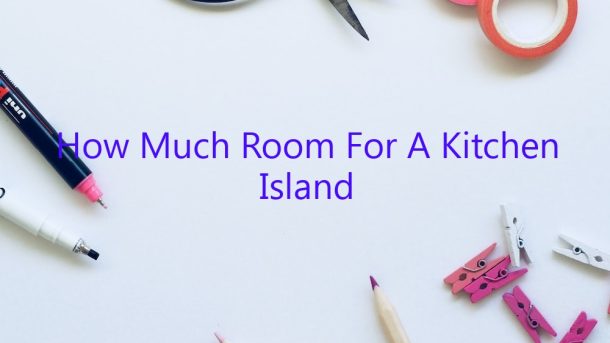When it comes to kitchen islands, there are a few things to consider. One of the most important is how much room you have to work with.
If you have a small kitchen, you may not have enough room for a full-sized island. In that case, you may want to consider a smaller option, such as a breakfast bar or a peninsula. These options take up less space and are still a great way to add extra counter and storage space to your kitchen.
If you have a larger kitchen, you may have more room for a full-sized island. This can be a great way to add extra counter space, storage space, and seating. It can also be a great way to create a focal point in your kitchen.
When choosing an island, be sure to consider the size of your kitchen and the amount of space you have to work with. You also want to consider the features you want in an island. Do you need extra counter space? Storage space? Seating? Once you know what you need, you can start shopping for the perfect island for your kitchen.
Contents [hide]
How much room do you need around a kitchen island?
If you’re considering adding a kitchen island to your home, you’ll want to make sure you have enough room to accommodate it. But how much room do you need around a kitchen island?
The answer to that question depends on the size of your kitchen and the size of your island. In general, you’ll want at least 36 inches of clearance on all sides of the island, but you may need more if your island is large.
If you’re tight on space, you may want to consider a smaller island. Kitchen islands can be quite large, and if you don’t have enough room to accommodate it, it will just end up taking up space in your kitchen.
If you’re unsure about how much room you need, it’s always a good idea to consult with a professional. They can help you determine the size and shape of island that will best fit your needs.
What is a good size for a kitchen island?
A kitchen island is a great way to add extra counter and storage space to your kitchen. When choosing a size for your kitchen island, there are a few things to consider.
The first thing to consider is how much space you have in your kitchen. If your kitchen is small, you may want to choose a smaller island that won’t take up too much space. If you have a lot of space, you can choose a larger island that will give you more storage and counter space.
Another thing to consider is how you will use your kitchen island. If you plan to use it mainly for storage, you may want to choose a smaller island. If you plan to use it for cooking and dining, you may want to choose a larger island.
Finally, consider the style of your kitchen. If your kitchen is styled with a lot of cabinets and counter space, you may want to choose a smaller island. If your kitchen has a more open layout, you may want to choose a larger island that will be the focal point of the room.
What is the minimum space between island and counter?
When planning a kitchen, one of the most important decisions is how to layout the countertops and islands. One of the factors to consider is the minimum space between the two.
There is no one-size-fits-all answer to this question; it depends on the size and shape of your kitchen. However, a good rule of thumb is to leave at least 36 inches between an island and a counter. This will give you plenty of space to work around the island and move around comfortably.
If your kitchen is especially small, you may need to leave less space between the island and counter. Conversely, if your kitchen is large, you may be able to get away with a little more space. Just be sure to test out different layouts in your kitchen to see what works best.
Ultimately, the best way to determine the right spacing between an island and counter is to think about how you will use the space. If you plan to use the island as a dining area, for example, you will need more space between the two. If you will only be using the island for prep work, you can get away with less space.
No matter what, be sure to leave enough room for appliances, such as a refrigerator or dishwasher, that may need to be in close proximity to the island.
When it comes to kitchen design, there are a million small decisions to make. But by taking the time to consider the minimum space between an island and counter, you can be sure that you are making the best possible layout for your kitchen.
How far should a kitchen island be from the wall?
A kitchen island is a great way to add counter space and storage to your kitchen. But one question you may have is, “How far should a kitchen island be from the wall?”
There is no one perfect answer to this question, as it depends on your individual kitchen layout and preferences. However, here are a few things to keep in mind when deciding how far your kitchen island should be from the wall.
First, consider how much space you need between the island and the wall. If you have a lot of appliances or cabinets against the wall, you’ll need more space between the island and the wall so you can access them comfortably.
Second, think about how you will use the space around the island. If you plan to use the space for seating, you’ll need to leave enough room for people to sit comfortably.
Third, consider the height of your kitchen island. If you have a lot of countertop space on your island, you may want to position it further away from the wall so you can use it comfortably.
Ultimately, it’s up to you to decide how far your kitchen island should be from the wall. But these are a few things to keep in mind when making your decision.
Does adding a kitchen island add value?
When it comes to home renovations, adding a kitchen island is a popular choice. But does adding a kitchen island add value to your home? The answer to that question depends on a number of factors.
One of the main reasons people add kitchen islands is for extra storage space. If you’re tight on kitchen storage, an island can be a great way to add extra room. However, if your kitchen is already adequately stocked with storage, an island may not be necessary.
Another thing to consider is how you’ll use your kitchen island. If you plan to use it as a prep area or as an eating area, it’s important to make sure the island is big enough to accommodate those needs. If you’re not sure how you’ll use the island, it’s a good idea to consult with a kitchen designer to get some ideas.
One of the biggest benefits of adding a kitchen island is that it can increase the value of your home. If you’re planning to sell your home in the future, an island can be a great way to make it more appealing to buyers.
So, does adding a kitchen island add value to your home? It depends on your specific needs and what you plan to use the island for. If you’re looking for extra storage space or to create a more functional kitchen, an island is a great option. However, if you’re not sure if an island is right for you, consult with a kitchen designer for advice.
How long should an island be to seat 4?
When it comes to kitchen islands, size does matter. You want to make sure that you have enough space to work comfortably, but you also don’t want the island to take up too much space in your kitchen. So how long should an island be to seat 4 people comfortably?
The general consensus is that an island should be at least 4-5 feet long. This will give you enough space to comfortably seat 4 people, as well as have enough room for a few prep areas or storage cabinets. If you’re looking for something a little larger, you can go up to 6 or 7 feet long. But remember, the longer the island, the more space it will take up in your kitchen.
If you’re not sure whether an island will fit in your kitchen, you can always use online kitchen design tools to help you visualize the space. This will give you a better idea of how the island will look and how much space it will take up.
So if you’re looking for a new kitchen island, make sure to keep these dimensions in mind. A 4-5 foot island is the perfect size for most kitchens, but you can go up to 6 or 7 feet if you need more space.
Are kitchen islands out of style?
Kitchen islands have been popular for a long time and are not going out of style any time soon. They are a great way to add extra counter and storage space to your kitchen. Kitchen islands can also be used as a breakfast bar or a place to eat dinner. There are many different types of kitchen islands available, including stationary and portable islands.
If you are looking for a way to add more counter and storage space to your kitchen, a kitchen island is a great option. Kitchen islands can be used as a breakfast bar, a place to eat dinner, or a place to store appliances. There are many different types of kitchen islands available, including stationary and portable islands.
If you are thinking about adding a kitchen island to your kitchen, there are a few things to consider. First, decide how you will be using the island. If you plan to use it as a breakfast bar, make sure there is enough space for a table and chairs. If you plan to use it as a place to eat dinner, make sure the island is big enough to accommodate a dining table.
Another thing to consider is the height of the island. If you are planning to use the island as a place to eat dinner, make sure the island is the right height for a chair. If you are using the island as a place to store appliances, make sure the height is comfortable for you to reach.
Finally, think about the style of your kitchen. If your kitchen has a traditional style, a traditional kitchen island may be the best option. If your kitchen has a modern style, a modern kitchen island may be a better option.




